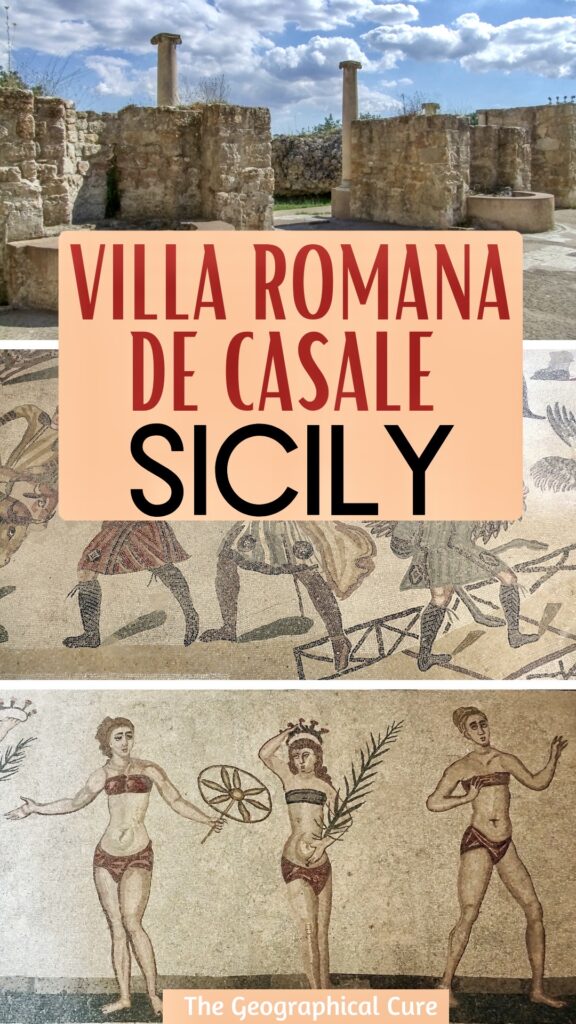Here’s my guide to visiting the UNESCO-listed Villa Romana del Casale in Sicily. It’s an incredibly mosaicked country villa built by Roman aristocrats in the 4th century.
Tucked away in a remote area of central Sicily, it’s a bit of a hidden gem. Nonetheless, it was one of my very favorite stops on a recent trip to Sicily.
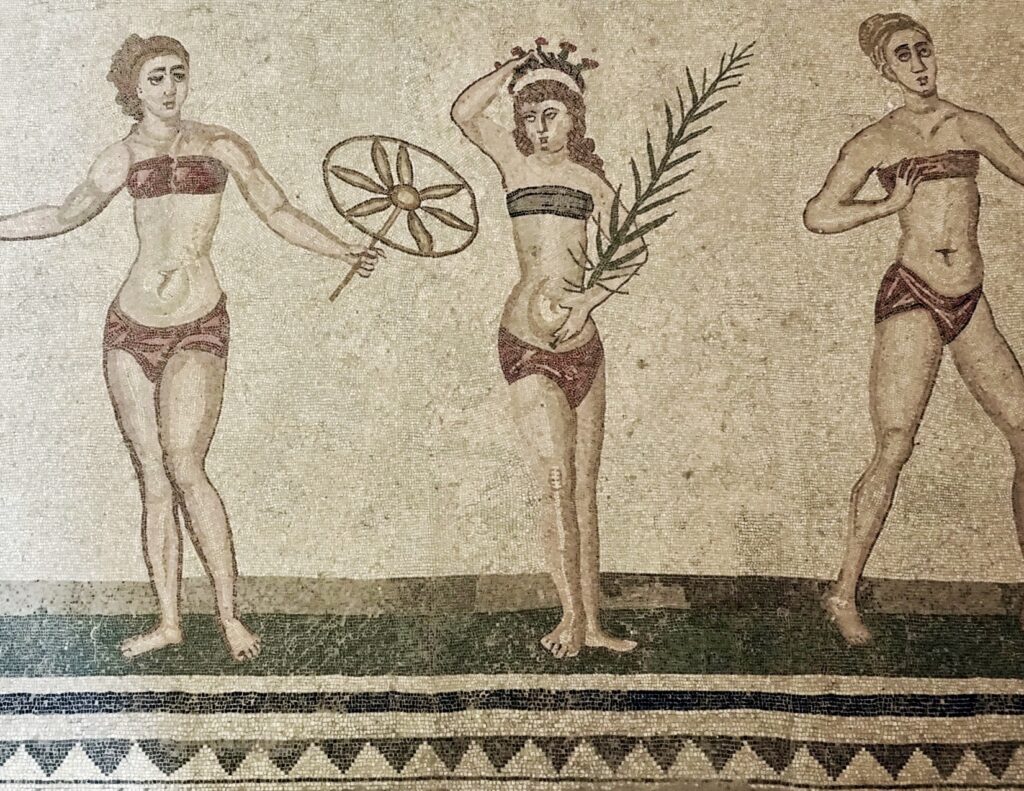
I’ve seen plenty of Roman mosaics in my time, from museums in Rome to the Getty Villa in Los Angeles. But nothing compares to this treasure chest villa, not even remotely.
Villa Romana del Casale has the world’s largest collection of in situ Roman mosaics — 3,700 square feet.
They’re well-preserved and truly incredible, some of the most whimsical and detailed mosaics from the ancient world I’ve seen.
The time capsule villa gives you an “up close and personal” look at just how extravagantly aristocratic Romans once lived. You can almost imagine the big shots, clad in togas, heading off to discuss politics in the board room.
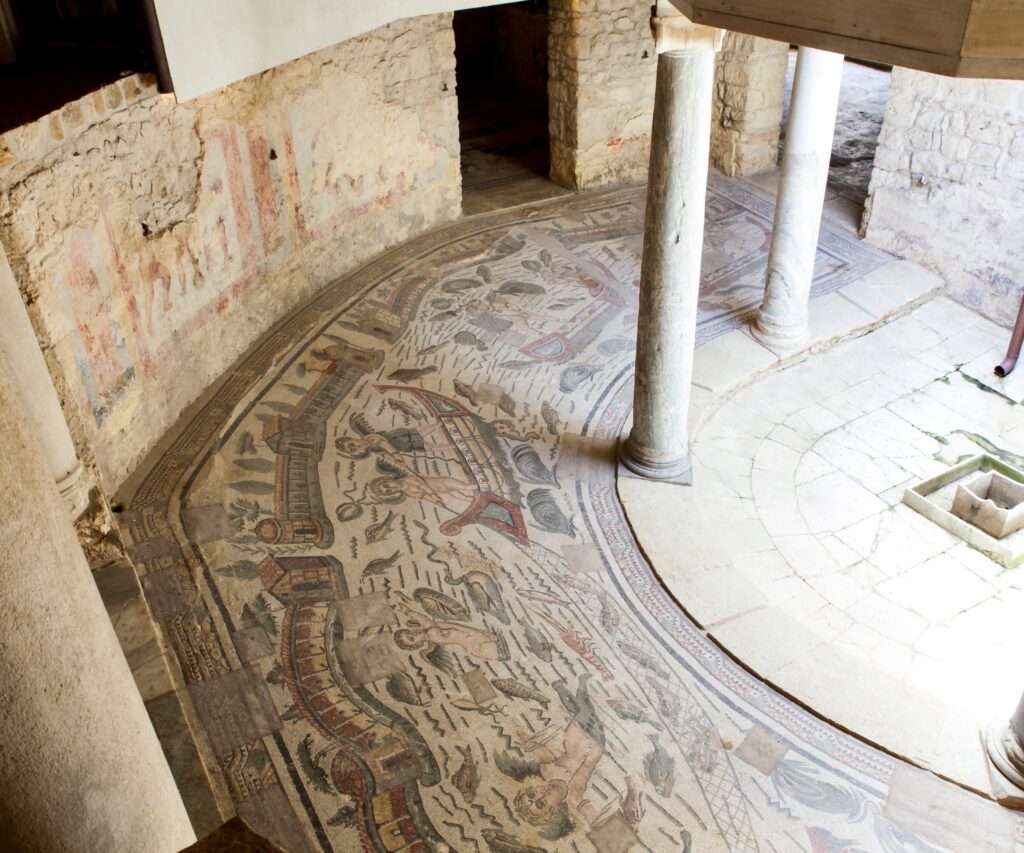
History of the Villa Romana del Casale
In 300 A.D., a rich aristocrat built the Villa Romana del Casale. At the time, the Roman Empire was falling apart and wealthy Romans were inclined to build their swishy palaces away from all the chaos.
The villa included over 60 rooms on four levels. Each room had a theme.
The identity of the villa owner is not known with any certainty. One theory is that it was owned by an important Roman senator who imported and exported wild animals.
Another is that it was the country home of the Emperor Maximian, one of the four emperors in the first tetrarchy. The sheer size of the villa and the magnitude of the mosaics seem to suggest an imperial owner.
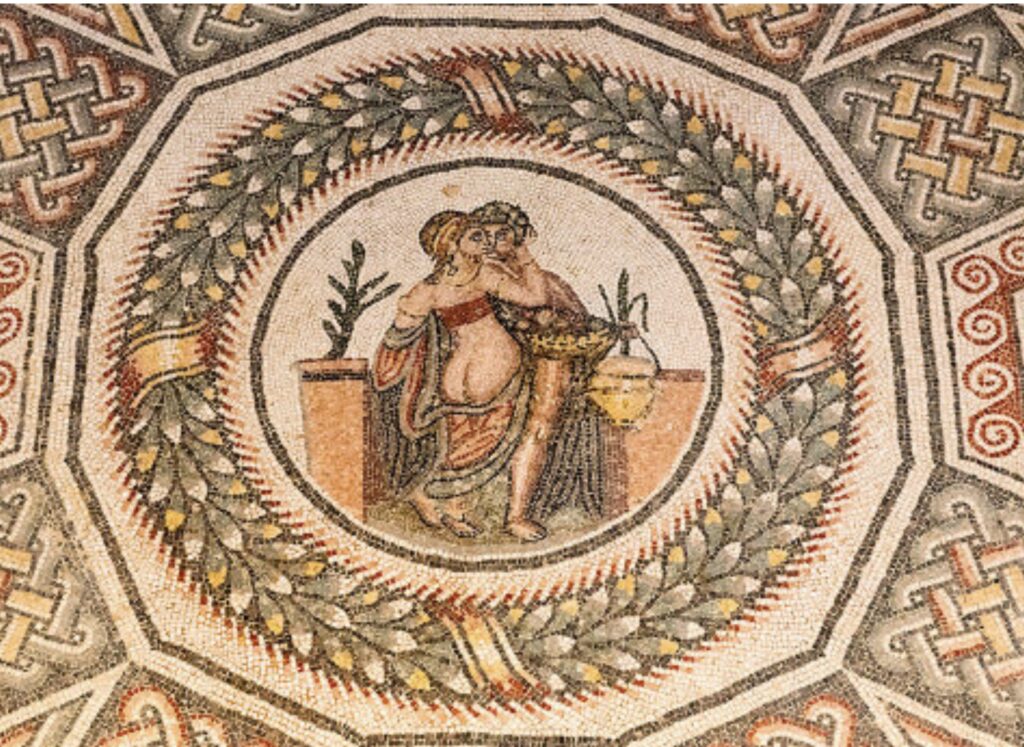
Whoever the owner, the villa, unlike other Roman ruins in Sicily, survived. This was partly due to its remote location, hidden away from would be looters.
But the main reason is that, in the 1300s, the villa was engulfed and buried in a massive landslide. It stayed safely hidden for 700 years.
The villa was excavated in the 1930s. But it wasn’t until the 1950s that the incredible mosaics were unearthed. The villa became a UNESCO site in 1997.
By 2012, the villa was fully restored. Archaeologists protected the mosaics by building structures to cover them. You’ll walk along steel paths and peer down at the mosaics.
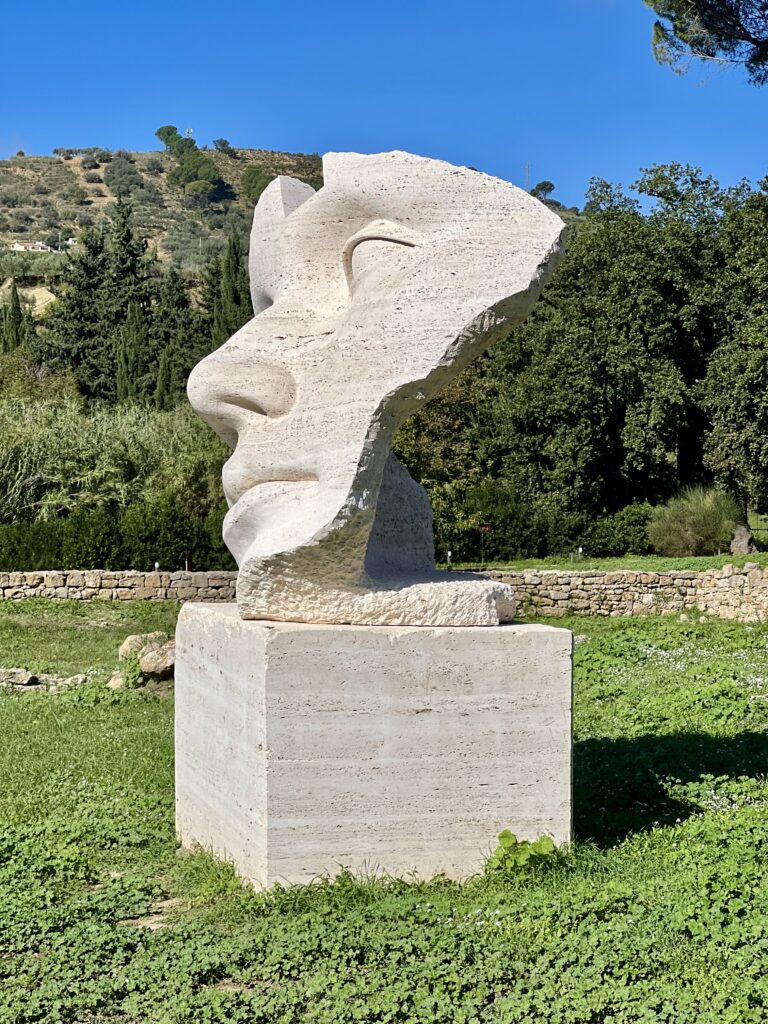
Tickets & Tours For Villa Romana del Casale
Tickets to the villa are 10 euros and you’ll also have to pay for parking. Take a ticket as you enter the lot and pay at the kiosk when you leave.
The parking lot is huge. There are pubic restrooms. You’ll also find vendors selling granita, fresh juice, and souvenirs.
If you don’t have a car, you can visit the villa on a guided tour from Catania, from Agrigento, from Palermo, or from Taormina.These tours combine the villa with a visit to the majestic Valley of the Temples in Agrigento.
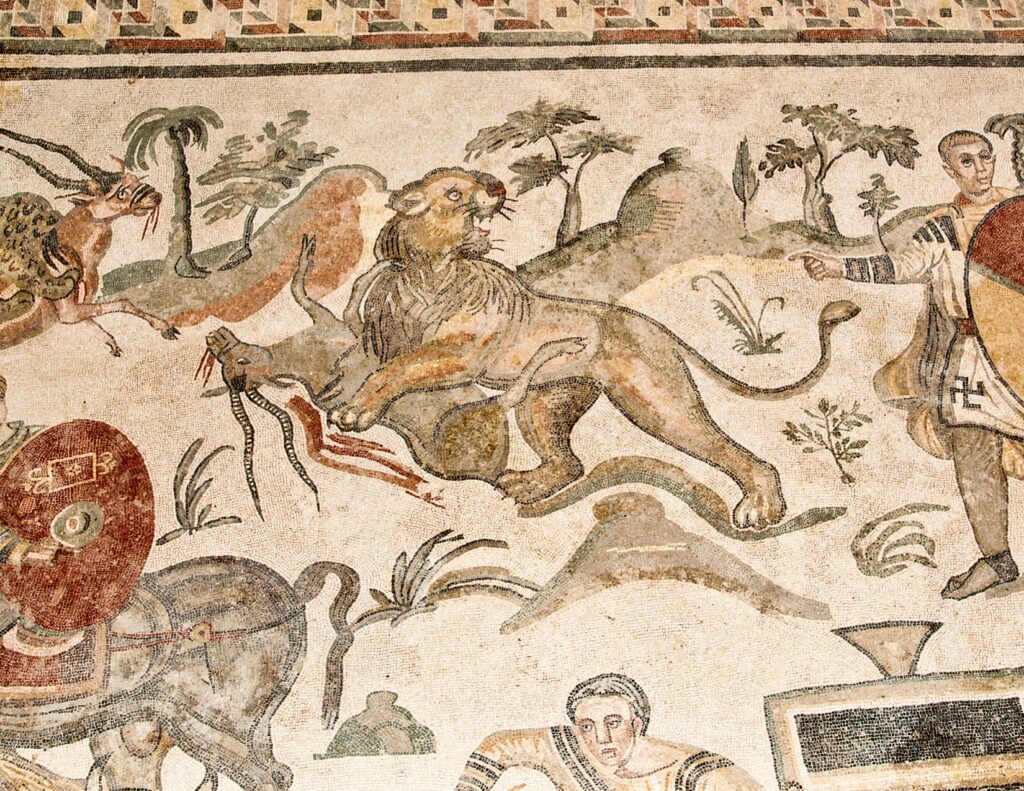
If you’re driving yourself, you can also book a 2 hour guided tour from an expert. I highly recommend this option.
There is plenty of signage in English and you can also pick up an audio guide (for 5 euros).
But I think a guide really brings the site and its stories to life. Plus, then you don’t have to devote a large part of your visit to reading signs.
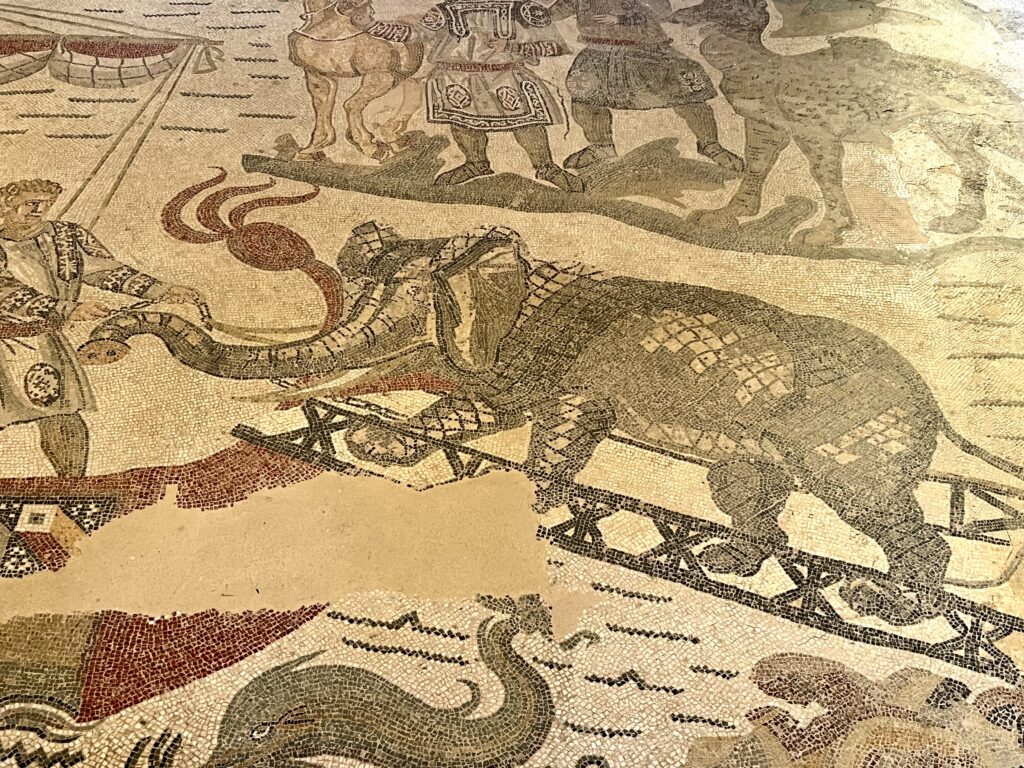
Understanding Roman Mosaics
Mosaics were a favorite decoration of the ancient Romans. They used them to decorate floors, walls, and even ceilings. They were a lavish way to spruce up a room while simultaneously supporting foot traffic.
Mosaics were made of marble, colored glass, and semi-precious stones. They were long lasting. Unlike frescos, for example, the color doesn’t deteriorate.
The Romans used local stones, but also imported mosaics in exotic colors. The ones at Villa Romana del Casale were likely made in northern Africa.
The villa’s mosaics have many themes. They involve hunting, athletics, mythology, and scenes from daily life. Some of them are narrative, telling action packed stories full of drama and violence.
The Romans didn’t just decorated the floors of important halls either, but also servant’s quarters, pantries, and latrines.
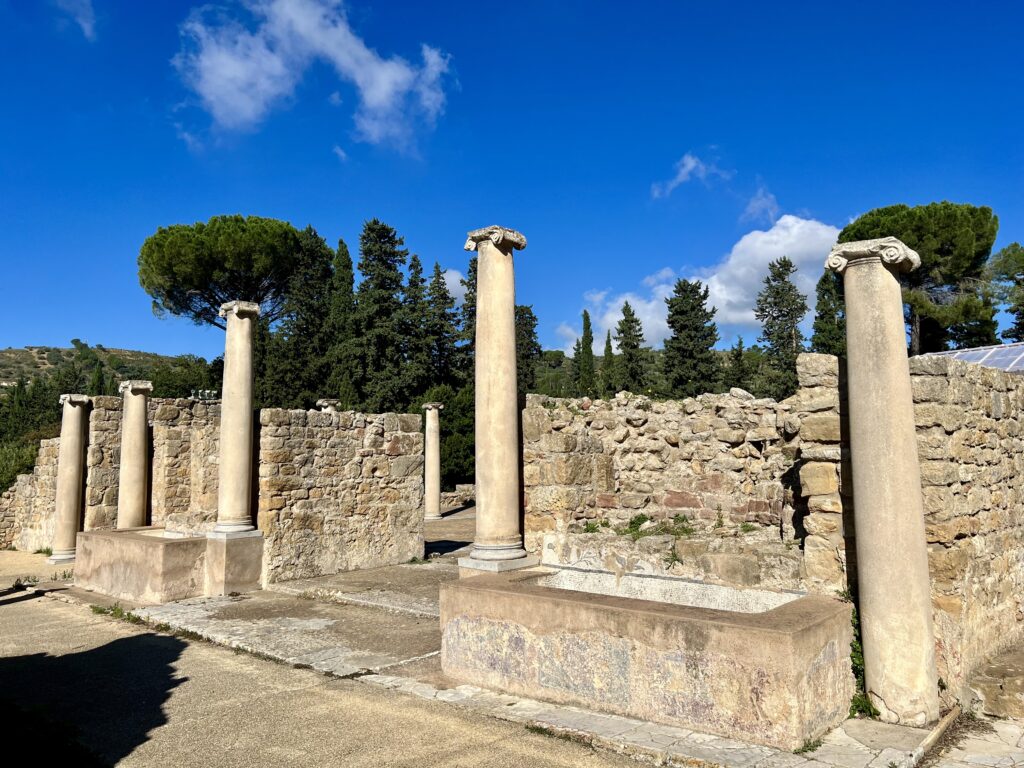
Guide To The Villa Romana del Casale: What To See
Here are the highlights of the Villa Romana del Casale. To admire them, you’ll follow a one way path on elevated walkways.
Monumental Entrance
The monumental entrance hall once had three huge arches, one a triumphal arch. Niches between the columns once held statues. You can still see traces of frescos, including a fragment of a horse and a military emblem with effigies of the four tetrarchs (more support for Maximian as the owner).
Entry Hall
Once inside, you’re in a porticoed entry hall. The hall was connected to four parts of the villa — the baths, the gym, the eastern peristyle, and the large latrine.
The Aedicula of Venus was the servants’ entrance to the baths. It features geometric designs traditionally associated with servants quarters. The room was given this name after small fragments of a statue of Venus were discovered there.
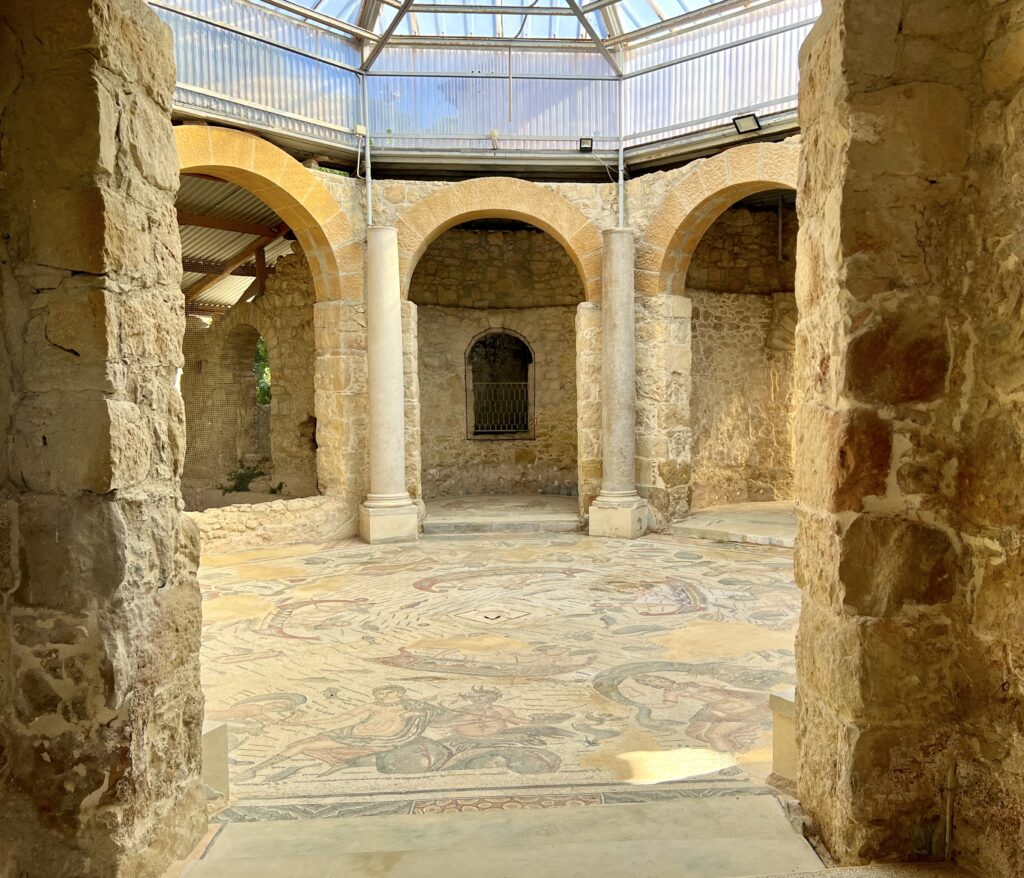
Baths
Romans loved their baths and were famously obsessed with hygiene. The villa baths are right at the entrance, so you could clean up before greeting your hosts.
The bathing process followed a specific regimen, much like today’s fancy spas. Romans would warm up in the tepidarium, sweat in the caladrium, and then jump in the cold frigidarium to close the pores.
After that, slaves would provide a massage and a good scrubbing with a curved metal scraper. It would remove everything — dirt, fleas, dead skin, and hair.
You’ll see the ruins of the tepidarium and the caladarium. In the tepidarium, you can see the exposed brickwork and vents that allowed hot steam into the room.
The best preserved bath is the frigidarium, which has a floor mosaic of sea gods. You’ll see a scene with tritons, dolphins, fishing cupids, and sea lions.
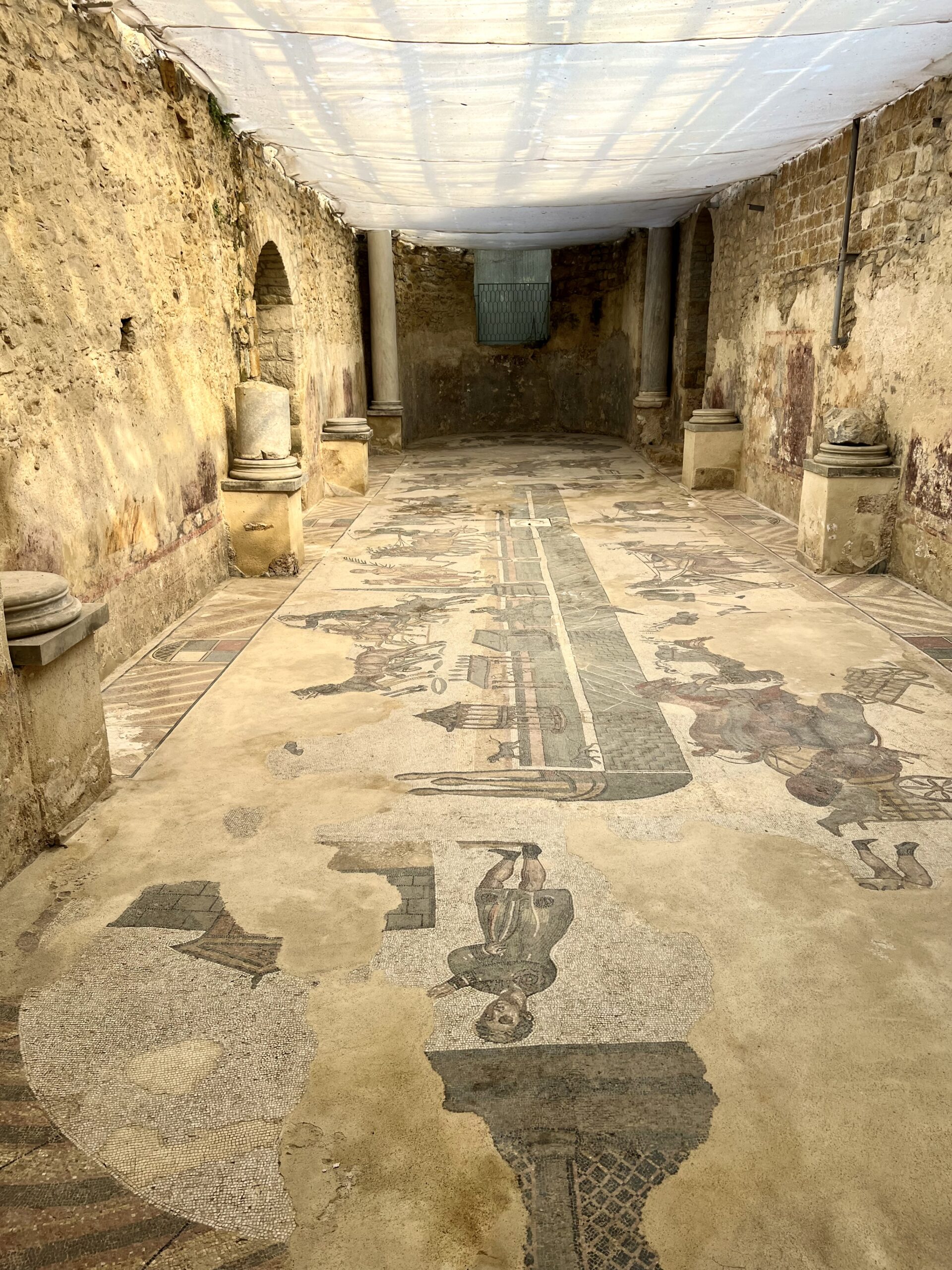
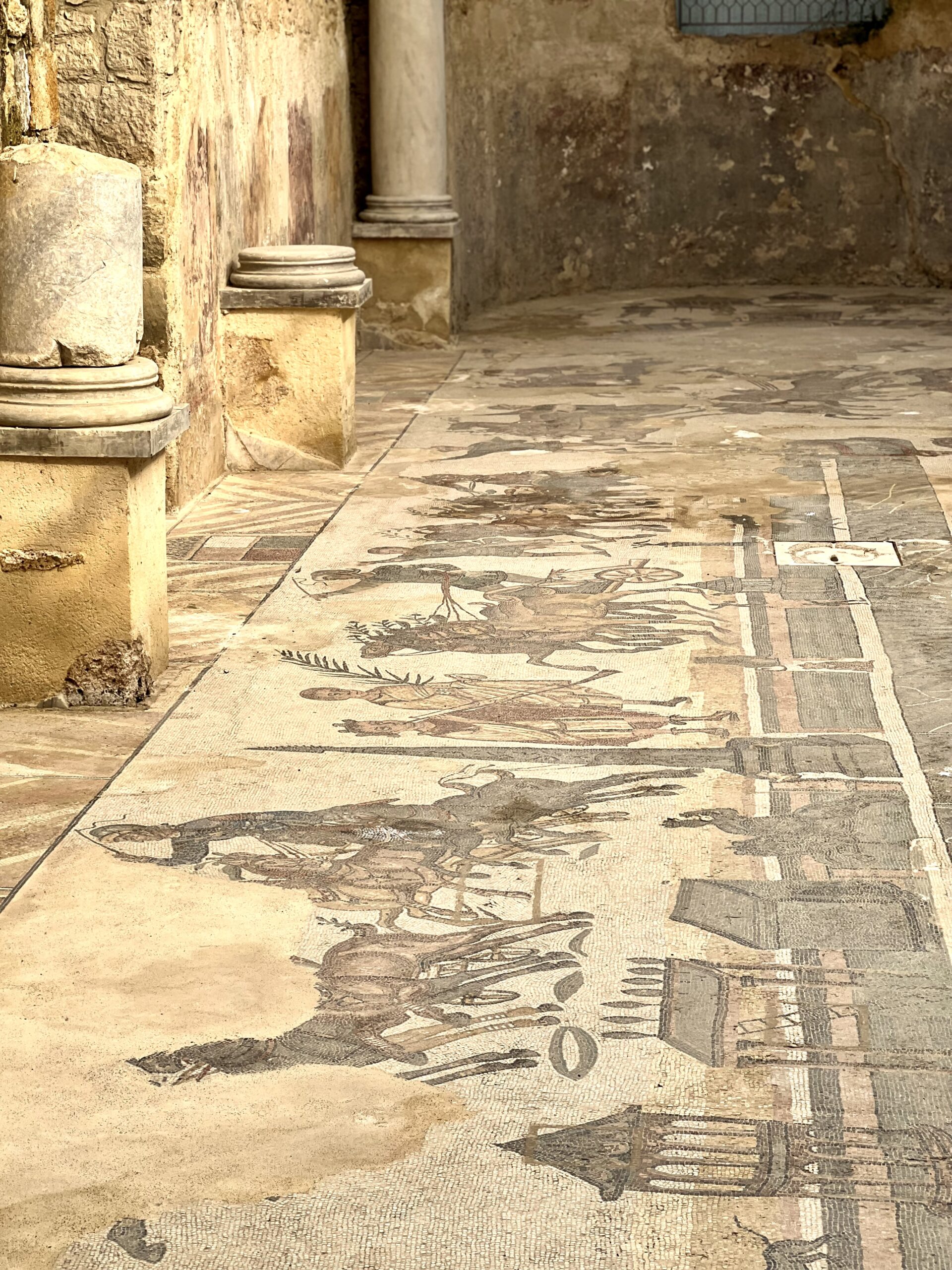
Palestra
Next, you’ll come to a beautiful room called the Palestra or Double Apsed Hall and get your first glimpse at the incredibly intricate mosaics.
This was an exercise room or gym. Sometimes guests would warm up their muscles before hitting the baths.
The mosaics depict chariot races held in the Circus Maximus. They were held in honor of the goddess Cerce, who cult was revered in Sicily.
The charioteers are clad in four different racing colors — white, blue, green, and red. You can see details of the four chariots.
Even the horses have expressions on their faces. The tuba player announces the end of the race.
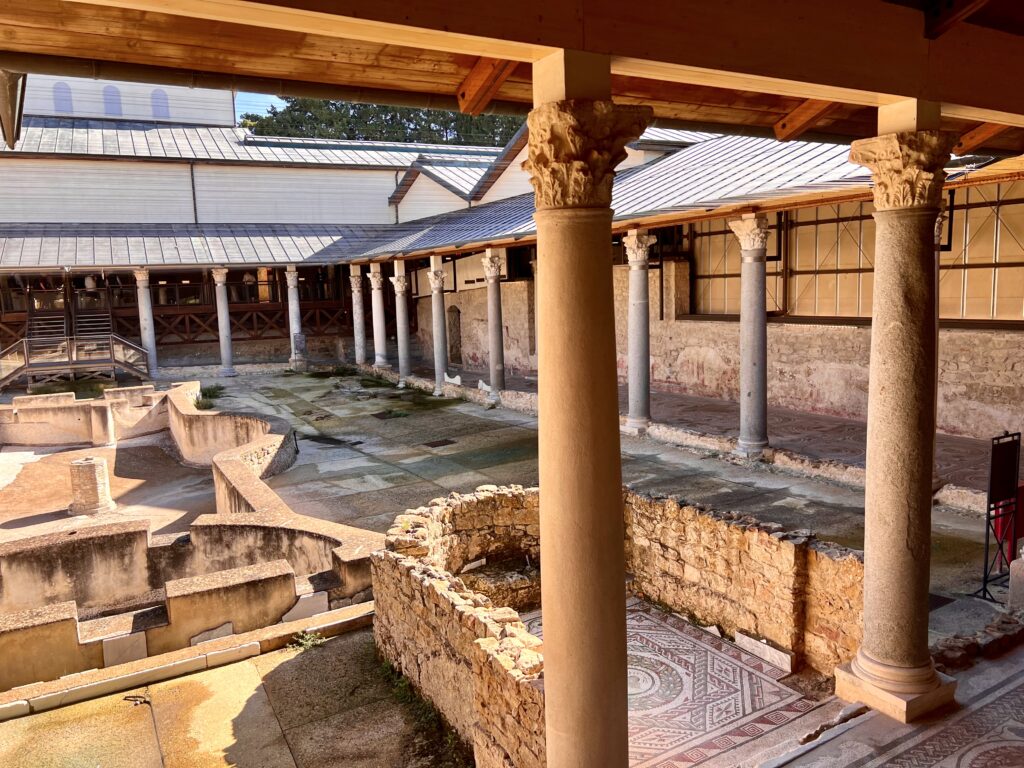
Peristyle Courtyard
Roman villas were typically built around a central courtyard. This one was very grand, approximately 41 by 20 feet long. Archaeologists have compared it the House of the Faun in Pompeii.
In the center was a fountain with three basins surrounded by gardens. People would walk in the arcaded pathways.
32 Corinthian columns once surrounded the peristyle. Today, you see several originals made of marble and granite. Others have been reconstructed.
The floor mosaics follow a single design, that of the head of an animal surrounded by a wreath. There are 162 squares of exotic animal heads ringing the perimeter. They may have served as a catalogue of the animals traded.
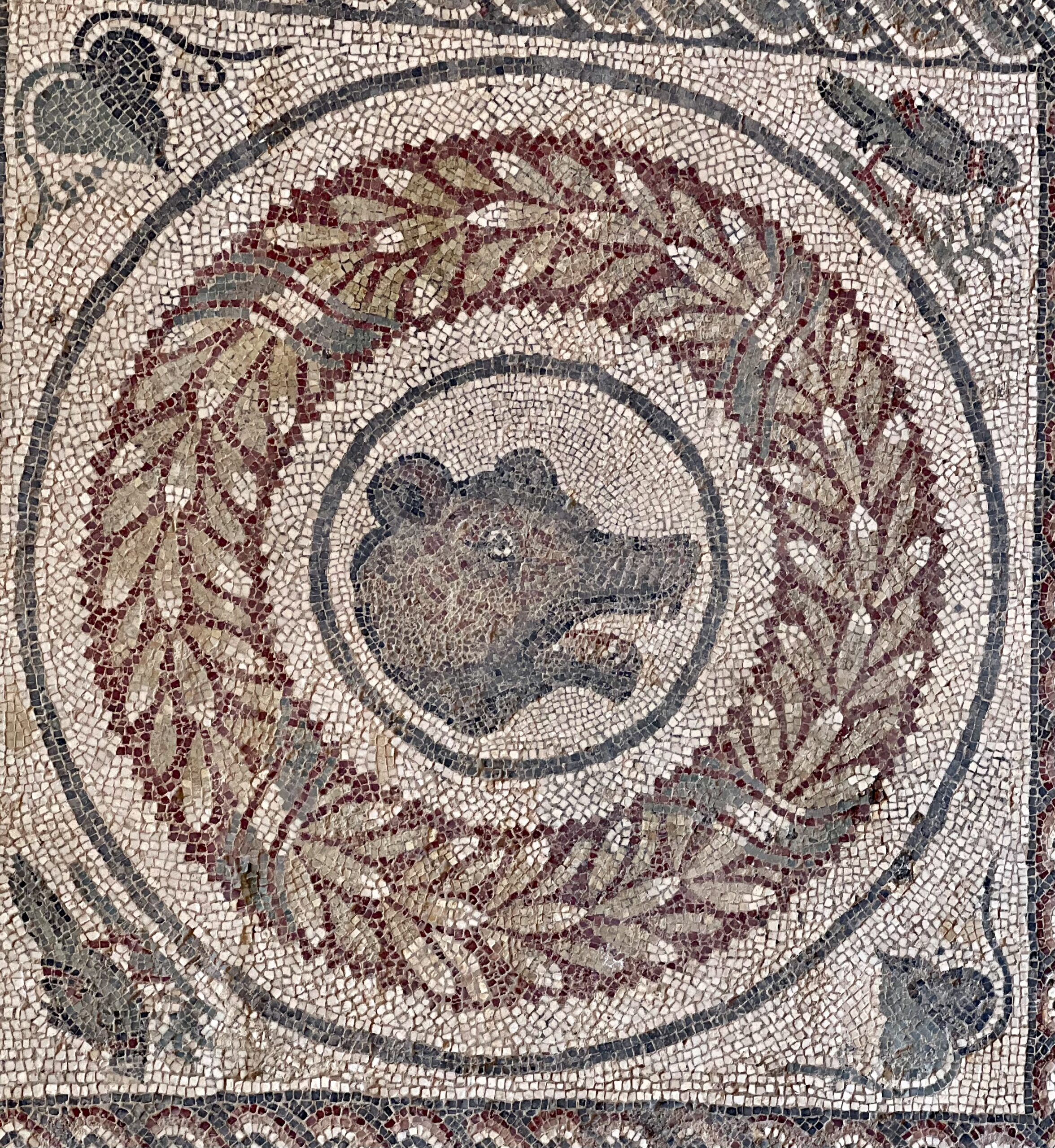
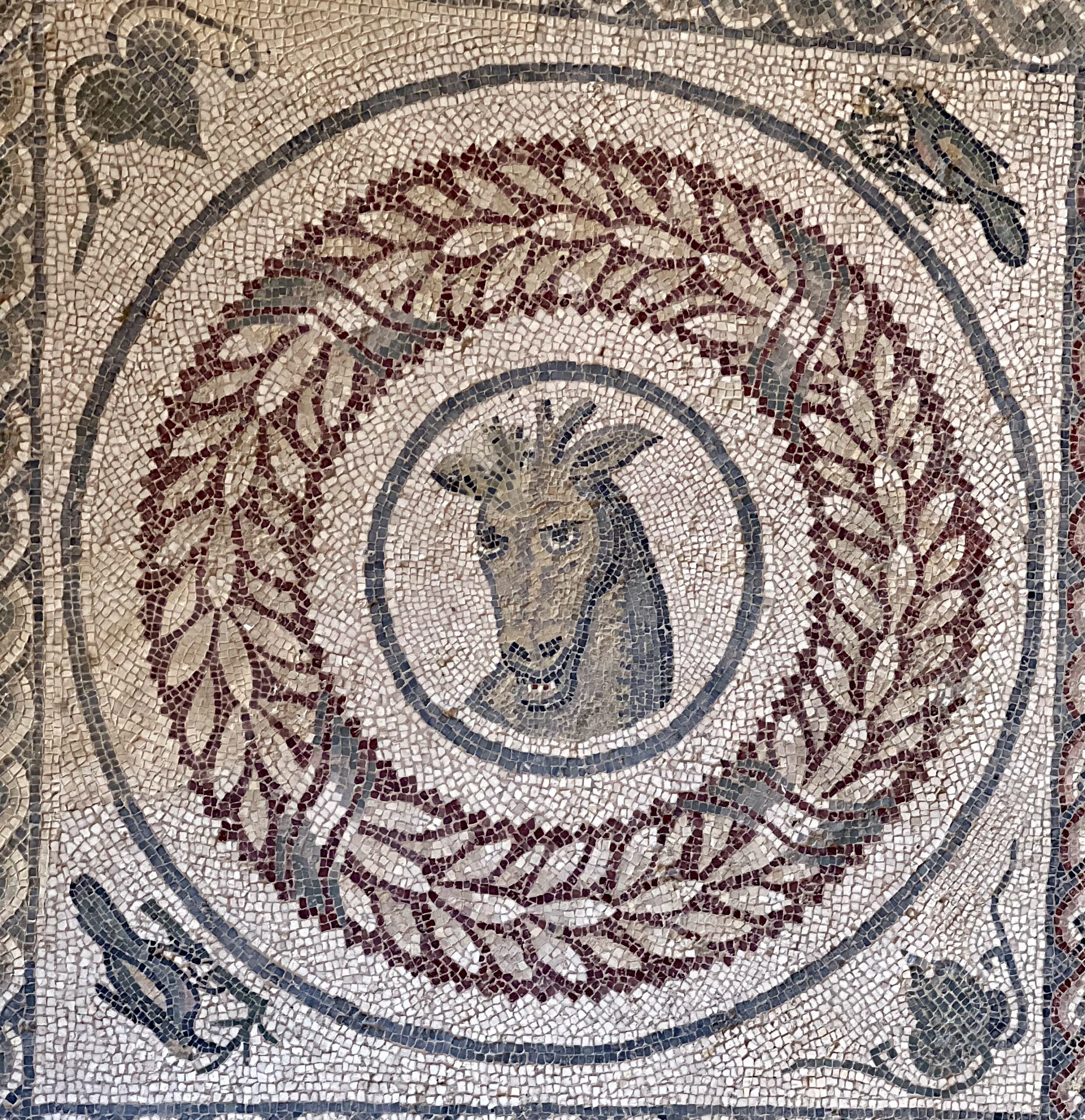
At the corners of the squares are ivy and birds. Some scholars think this imagery is evidence that the villa belonged to Emperor Maximian.
The main rooms of the villa are all clustered around the peristyle.
Guest Rooms
The first rooms you visit are the utility rooms (with geometric designs) and the guest rooms.
The Room of the Four Seasons features medallions representing the four seasons. The Room of the Fishing Cupids was likely the guest dining room. The detailed mosaics show cupids fishing with nets, harpoons, and fish traps.
The Hall of the Small Hunt is a rectangular room with elaborate hunting scenes in five registers. You “read” it from bottom to top.
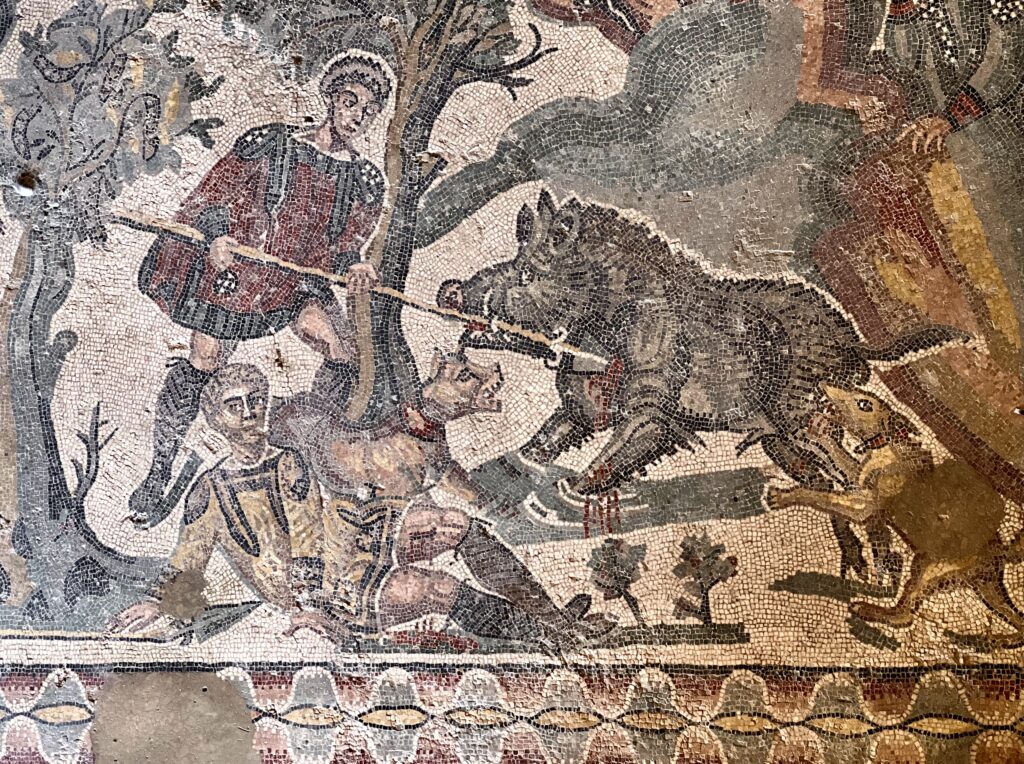
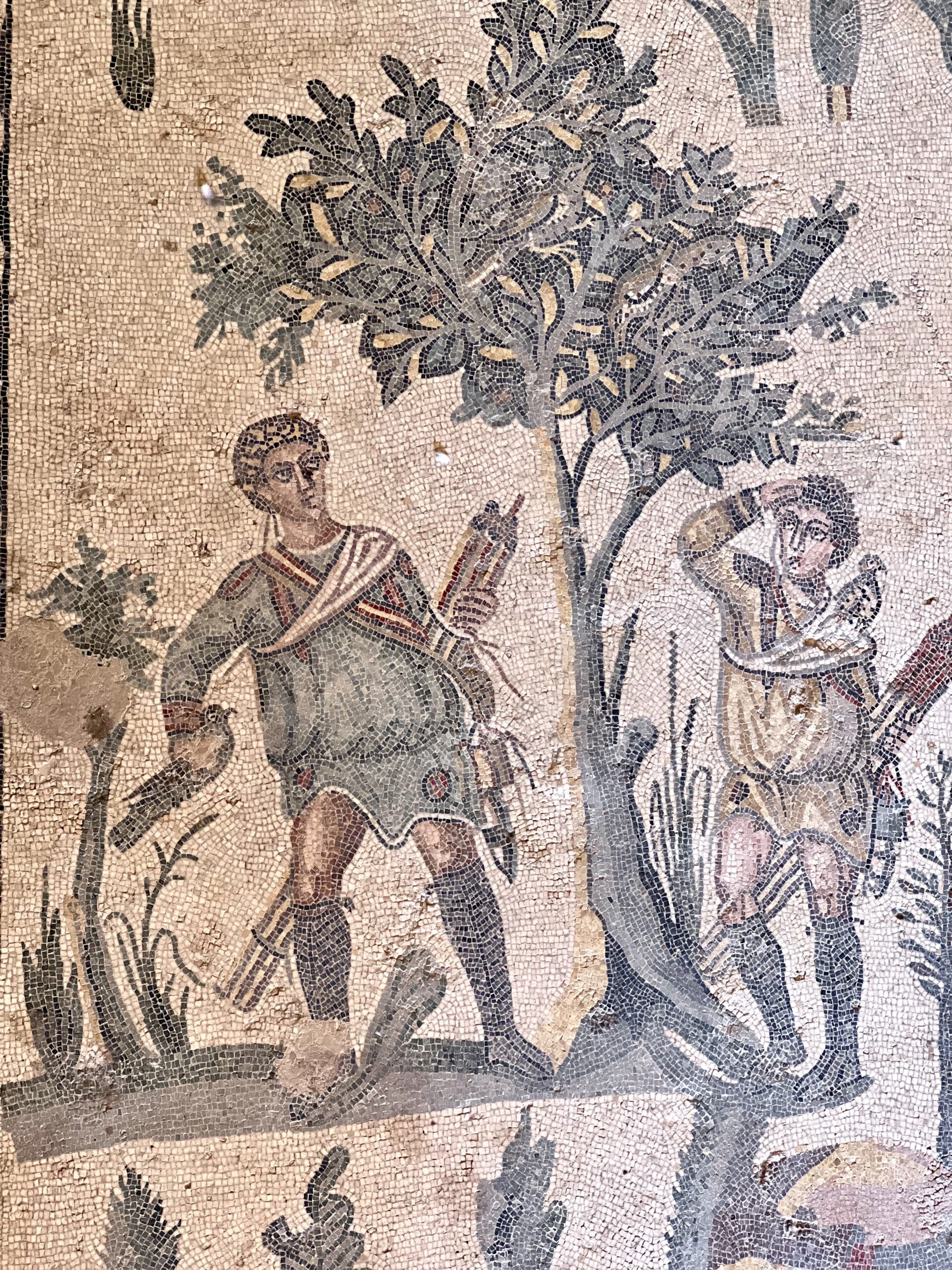
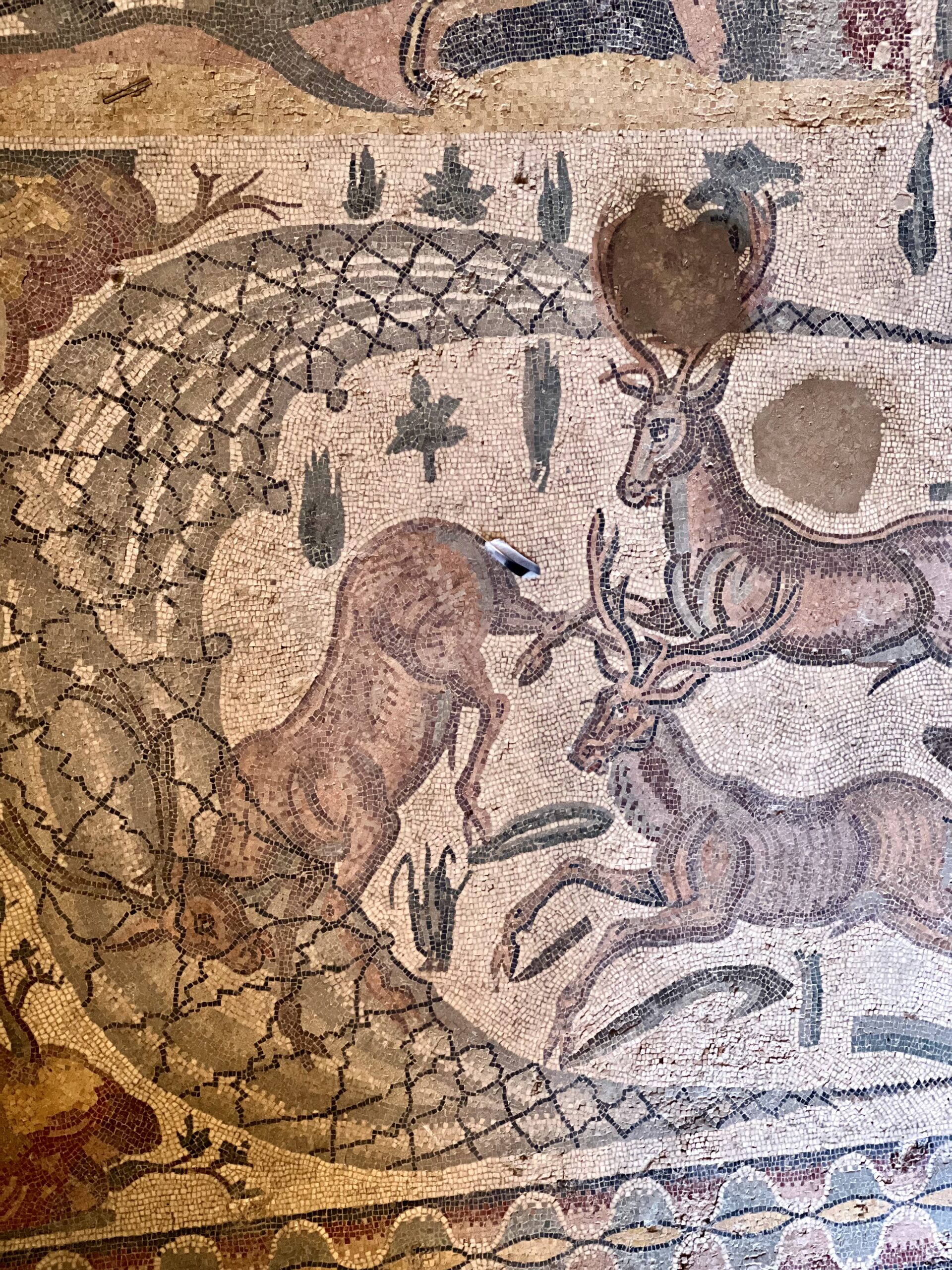
At the bottom, the hunt is in progress with dogs released into the countryside. There’s a dramatic scene with a wild boar being speared by a huntsman.
The next scene is a sacrifice to Diana, the goddess of hunting. Scholars assume that Maximian and his son are depicted.
In the middle, the hunters gather for a banquet under a large red tent as their slaves serve them. At the top, the hunters give thanks.
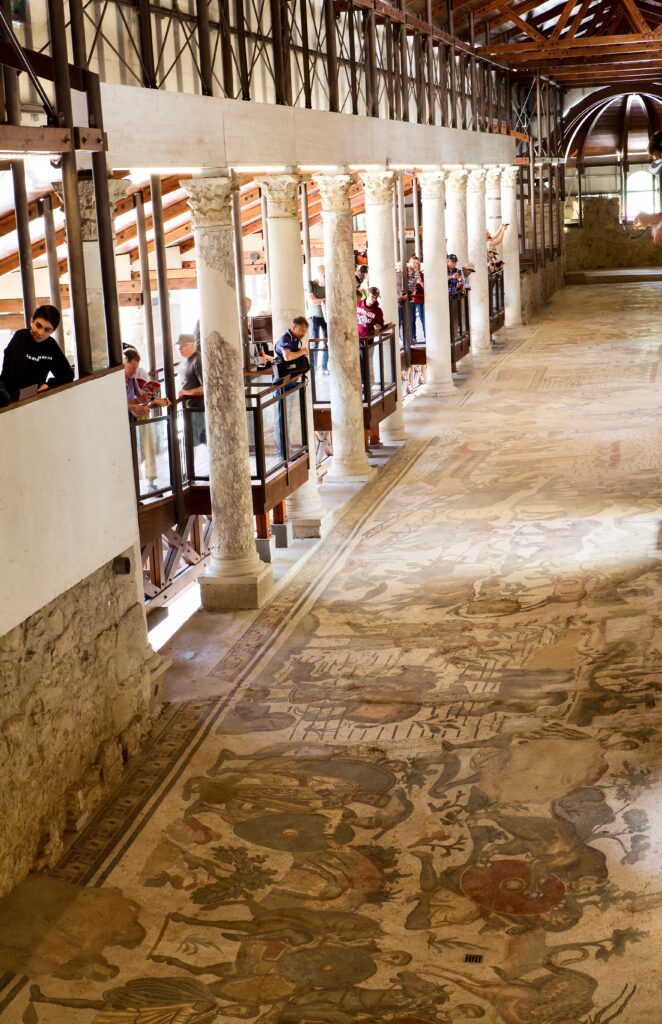
Ambulatory of the Great Hunt
You then arrive at the villa’s true showstopper — the Ambulatory of the Great Hunt. The grand hall is the artistic highlight of the villa, showing off the owner’s trading business and reflecting the Roman obsession with exotic animals.
The corridor functioned as a passageway for guests waiting to be officially received. It also connected the various sections of the villa.
The ambulatory is a continuous 200 feet corridor emblazoned with dramatic hunting scenes. It was specifically commissioned for this space. You’ll see all manner of animals — elephant, ostriches, deer, fish, rhinoceroses, lions, camels, etc. They’re very detailed and realistic.
The mosaics serve as a hunting manual. They illustrate the different phases of hunting wild animals, who were brought to Sicily to entertain the masses in amphitheaters.
You can see images of the animals being captured in Africa, loaded onto ships in the port of Carthage, and then landing in Ostia. Two officials, sticks in hand, supervise the operation.
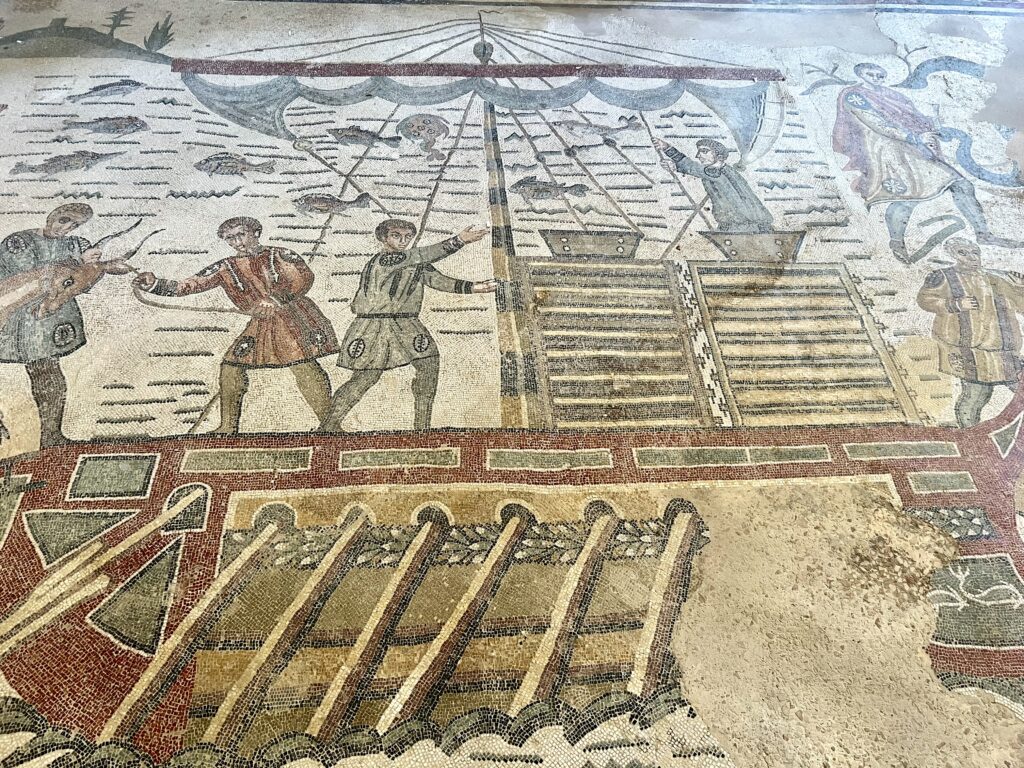
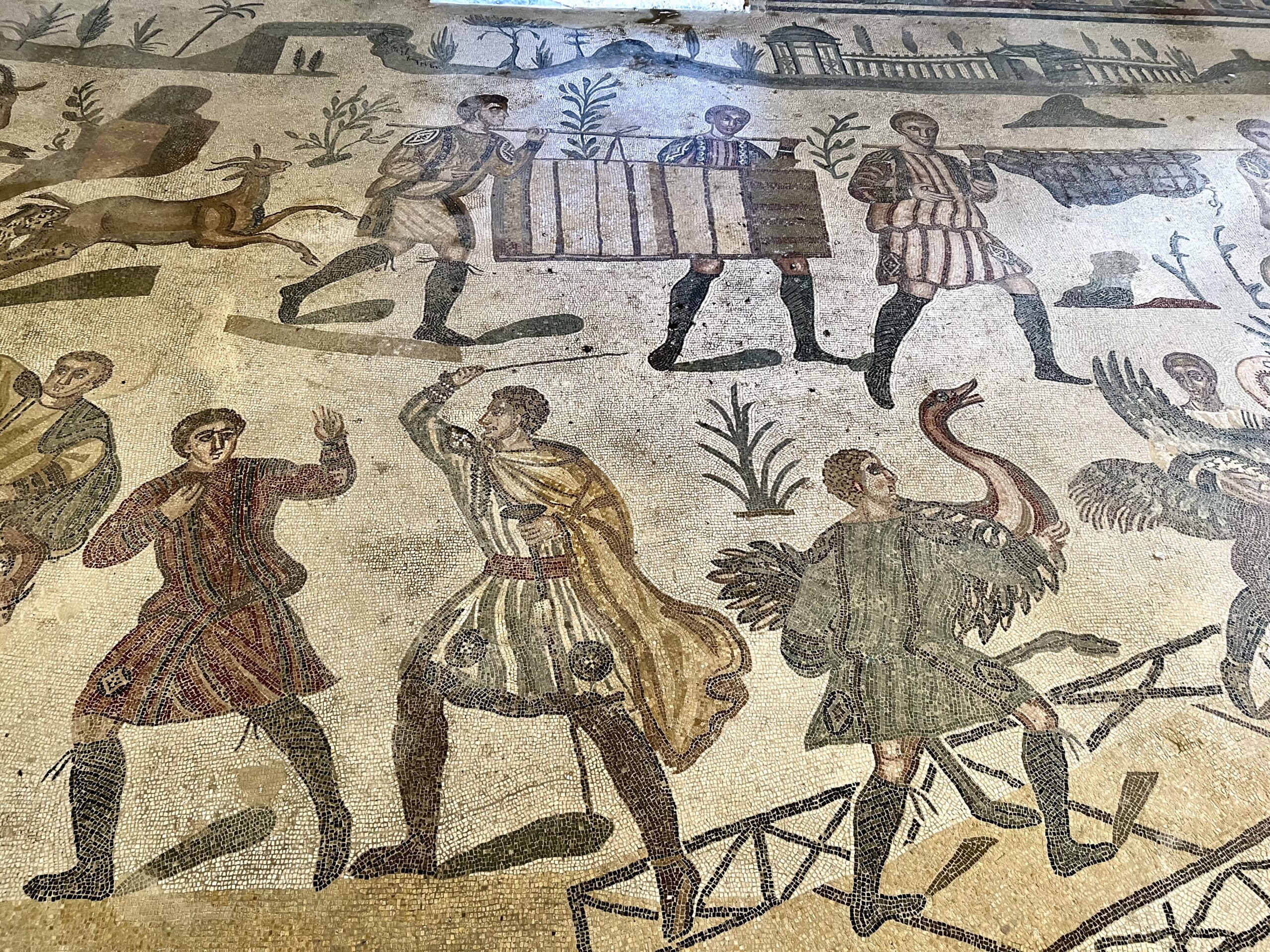
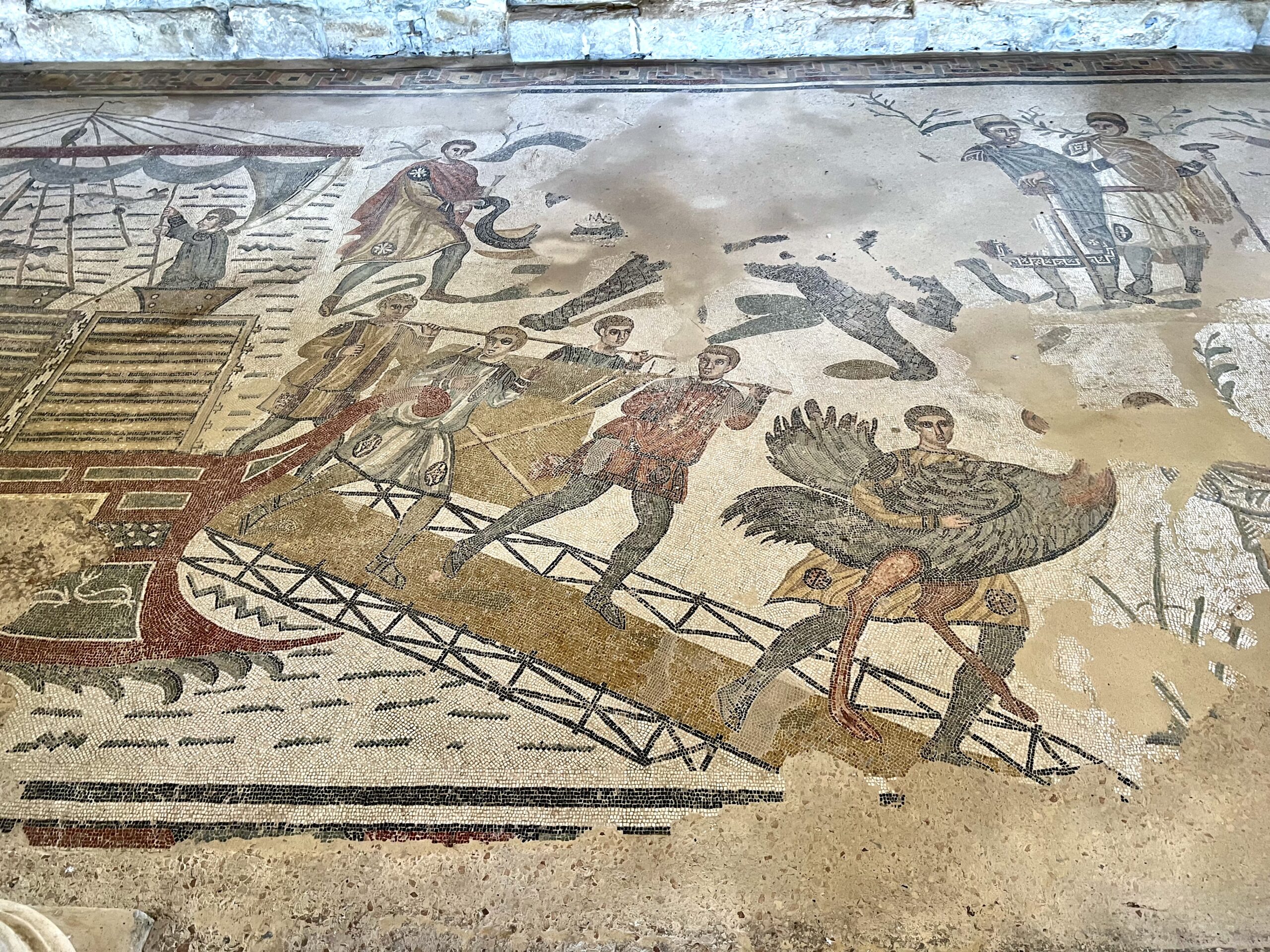
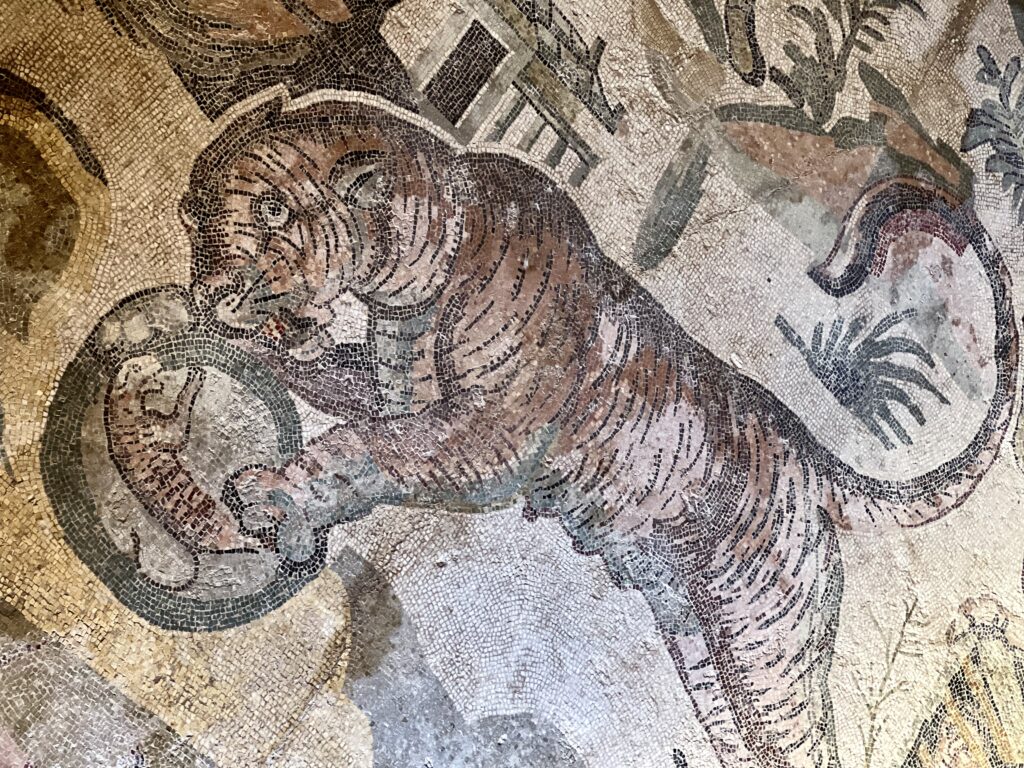
The Romans had ingenious ways for capturing the animals without killing them. For example, to capture the tiger cubs, a horseman distracts the mother tiger with a mirror. She thinks she sees her baby, but in reality it’s only a reflection.
Aristocrats, including possibly Maximian (identified by his headgear), witness the capture.
The Bikini Girls
In the gymnasium, you’ll find the villa’s most famous mosaics, the “Bikini Girls,” whose academic title is the Coronation of the Winner. The ten young women in bikini-like outfits show that workout gear hasn’t changed much in 2,000 years.
The Bikini Girls are, in reality, serious athletes training for games. You can see them lifting weights, running, and apparently playing beach volleyball. All with elegant hairdos.
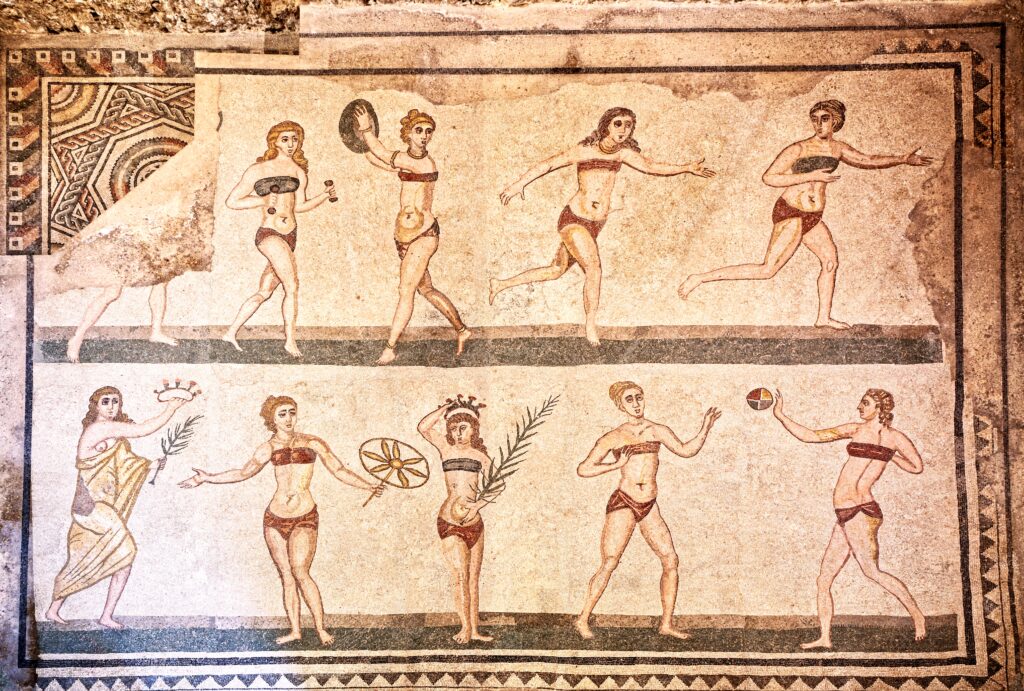
The one holding the discus is an aristocrat. You can tell from her jewels.
The winner sports a crown and palm frond, a symbol of victory. She’s given her crown by a woman clad in a translucent golden dress. To capture the translucency with mosaics is an incredible trick.
Master’s Southern Apartments
Because of their playful mosaics, scholars think the southern apartments were home to the villa owner’s children. The mosaics feature children as the protagonists.
You can see this in the Vestibule of the Small Circus and the Vestibule of Eros and Pan.
The son’s room was the Cubicle of Child Hunters. It features floral themes and boys engaged in hunting. Animals chase after the boys and a rooster bites a kneeling lad.
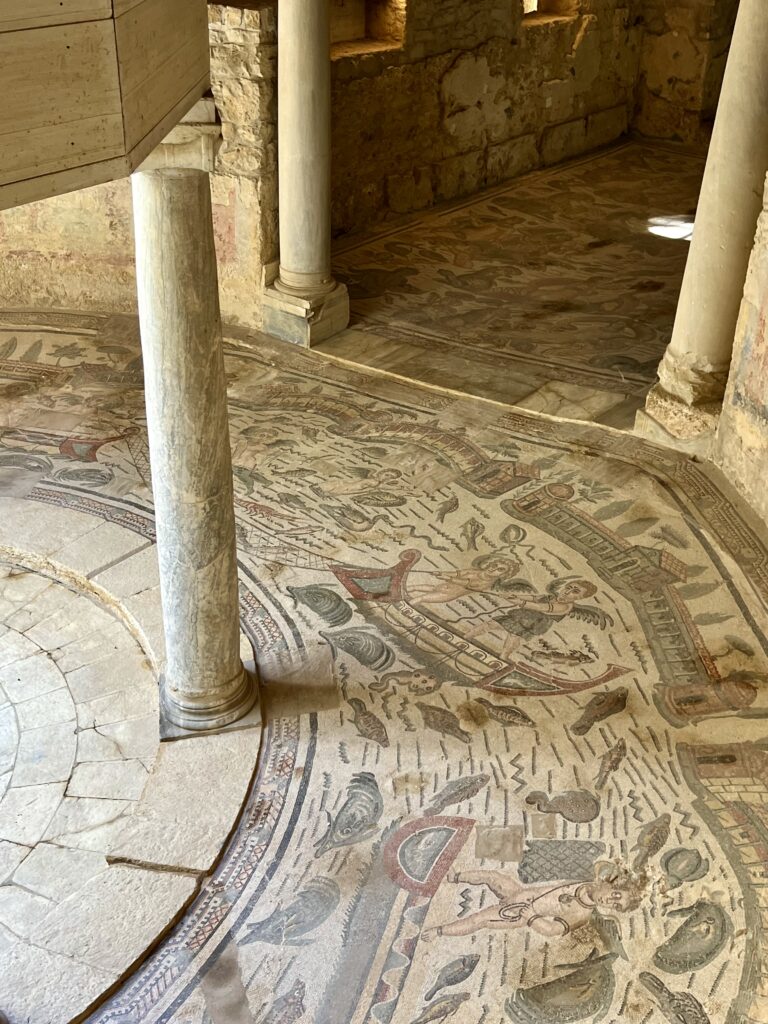
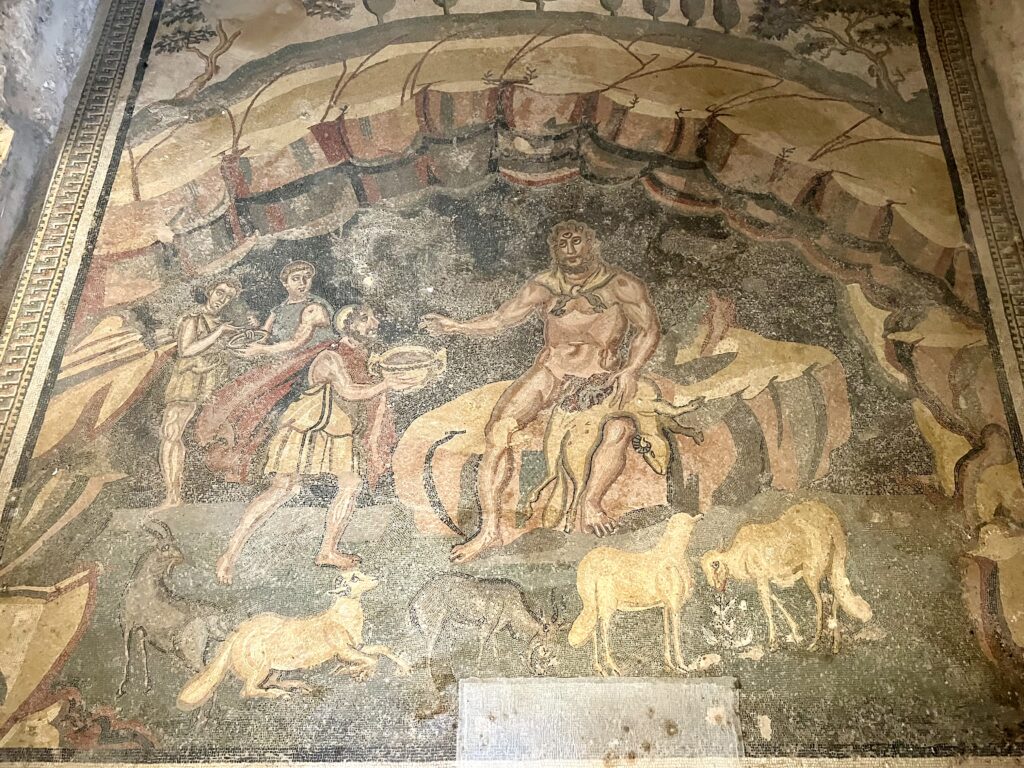
Master’s Northern Apartments
The Northern apartments were the living quarters of the owner and have fine mosaics.
As you enter, you’ll see a large mosaic of a famous episode from Homer’s Odyssey in the vestibule. In the center is Polyphemous, a man with three eyes. They don’t help him much, as Ulysses tricks him with a cup of “grape juice.”
In the next room is the master’s bedroom, consisting of two rooms. Above is a full moon and, at the center, a famous medallion. It depicts an erotic scene. A young man with a crown embraces a young girl while she’s undressing.
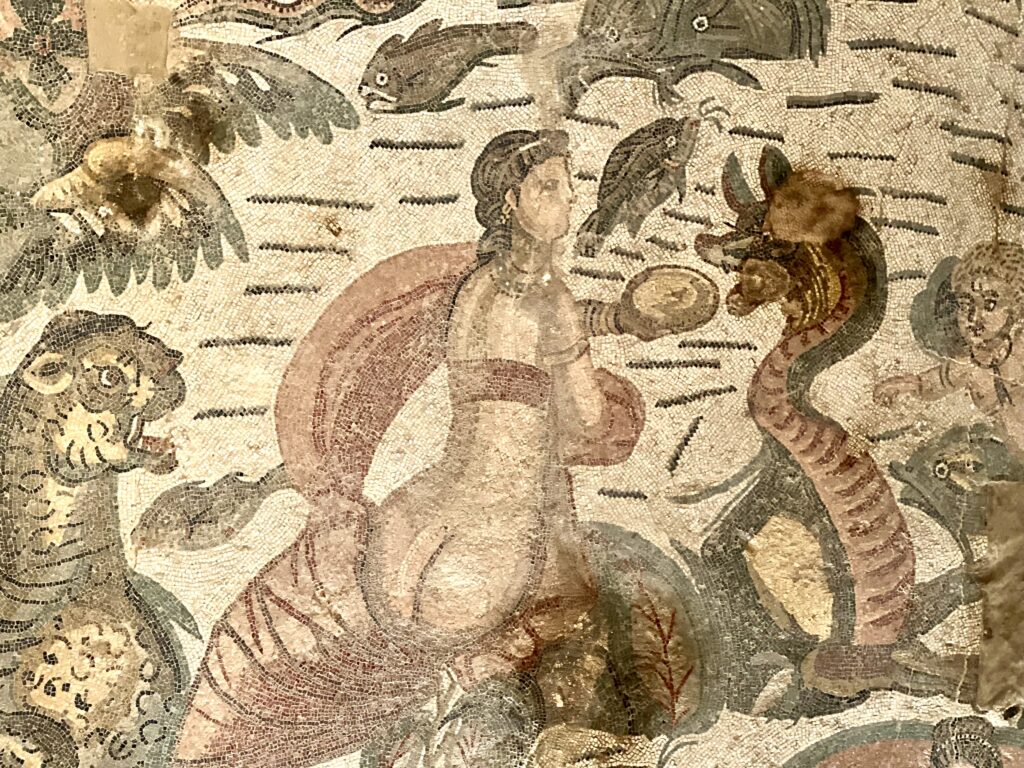
The rest of the room is decorated with busts of women depicting the four seasons, masks, and geometric design.
The master’s wife slept in the Fruit Cubicle. The walls and ceiling were once decorated with frescos. Today, you can only spot a tiny cupid. The floor mosaics depict various types of fruit — pomegranates, grapes, peaches, apples, etc.
Triclinium
The triclinium was unfortunately closed for renovations when I visited. But it likely served as the great dining hall for guests.
It’s an artistic highlight of the villa, with the floor mosaics featuring the 12 labor of Hercules in the center. The cults of Bacchus and Hercules are also represented.
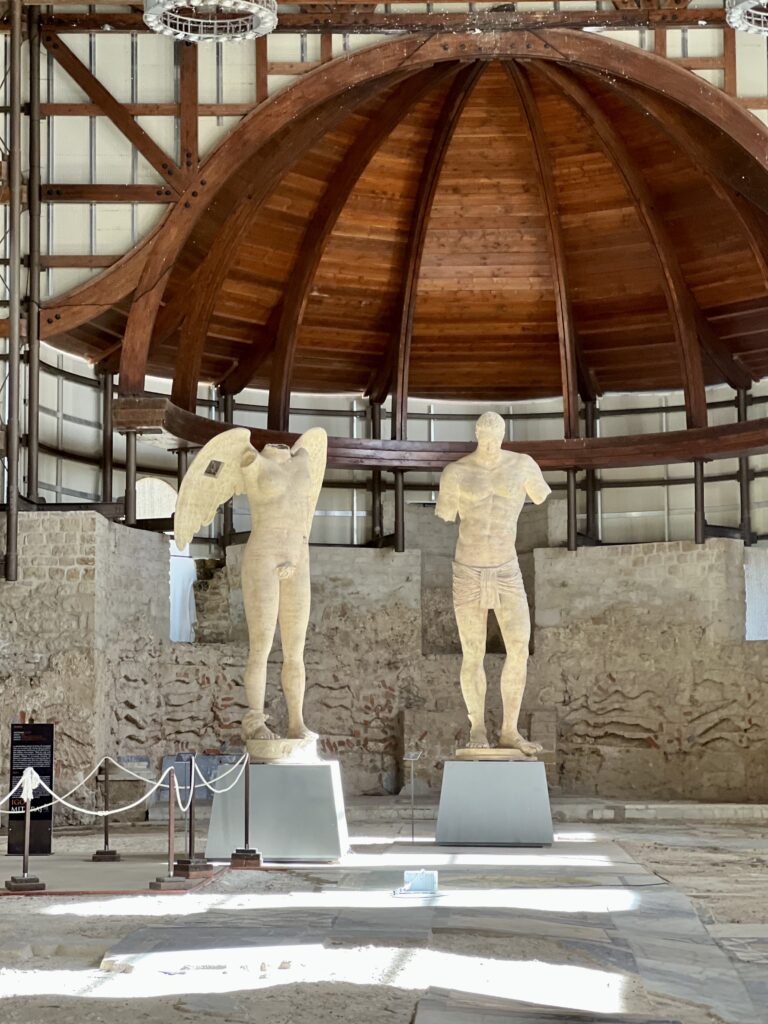
Basilica
One usually thinks of “basilicas” as churches. But, in ancient Rome, a basilica was a grand public hall serving as a meeting place.
The villa owner would have received guests seated on his throne and administer justice.
There aren’t any mosaics in this room. Instead, the floors are covered in porphyry and polychrome marble slabs and some remains are still visible.
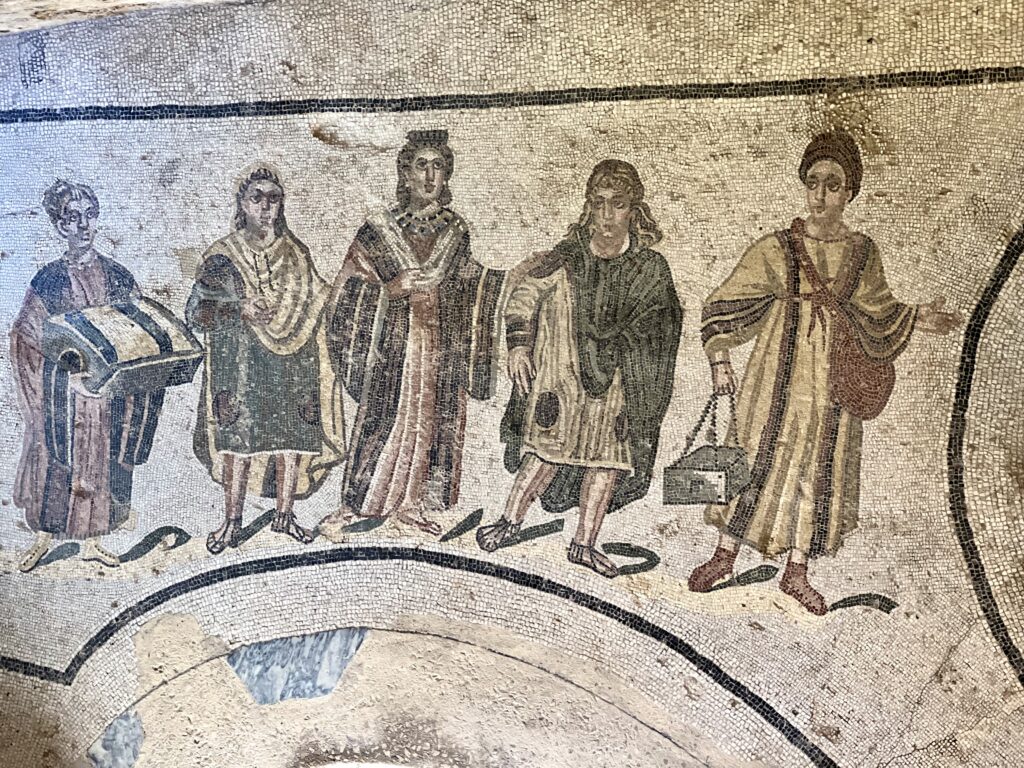
Tips For Visiting Villa Romana de Casale
The villa is near the town of Piazza Armerina. From there, it’s around a 1.8 mile walk. There’s also a local bus.
I mentioned guided tours above. But you can also stay in Piazza Armerina itself.
The villa also makes a nice road trip stop if you are driving from Agrigento to Syracuse or Catania.
I hope you’ve enjoyed my guide to the Villa Romana del Casale. You may enjoy these other Italy travel guides and resources:
- 10 Day Itinerary for Italy
- 10 Day Itinerary for Tuscany
- 1 Week In Umbria Itinerary
- 35+ Historic Landmarks in Italy
- Tips for Visiting Italy
- 5 Day Itinerary for Rome
- 3 Day Itinerary for Rome
- 3 Day Itinerary for Florence
- 2 Day Itinerary for Venice
- 1 Day itinerary for Milan
- 2 days in Palermo Itinerary
If you need a guide to Villa Romana del Casale, pin it for later.
